
 National Children’s Gardening Week is a wonderful annual event that’s designed to inspire children’s curiosity around growing plants and gardening-related activities. It takes place during what is typically a warm period of the year. That’s important because it means seeds and plants will grow faster and need minimal protective measures from inclement weather. Speedy growing results will appeal to little ones!
National Children’s Gardening Week is a wonderful annual event that’s designed to inspire children’s curiosity around growing plants and gardening-related activities. It takes place during what is typically a warm period of the year. That’s important because it means seeds and plants will grow faster and need minimal protective measures from inclement weather. Speedy growing results will appeal to little ones!
We encourage children large and small to get involved in the event, which begins later in May. At the time of writing, there is plenty of time to prepare if families want to source things like seeds, seed trays, and eco-friendly compost, and to find out about any related events in their neighbourhoods. Today’s guide explains more about the event, the reasons for it, the benefits of taking part, and the kinds of gardening-related activities little ones can take part in. National Children’s Gardening Week is always an incredibly worthwhile, educational, and fun week — so don’t miss out!
When is National Children’s Gardening Week 2025?
 National Children’s Gardening Week coincides perfectly with the Spring Bank Holiday and May half-term school holiday, taking place from the 24th of May to the 1st of June 2025. It’s usually a lovely warm week and is perfect timing for children to make the most of the event and to maximise the many benefits of spending time around nature.
National Children’s Gardening Week coincides perfectly with the Spring Bank Holiday and May half-term school holiday, taking place from the 24th of May to the 1st of June 2025. It’s usually a lovely warm week and is perfect timing for children to make the most of the event and to maximise the many benefits of spending time around nature.
“Children love growing plants and love being involved in the garden but they’re often impatient, wanting to see instant results. National Children’s Gardening Week aims to capture children’s enthusiasm at a time when results are immediate.” — Event Organiser.
Why Children Should Take Part in the Event
The organisers of the event put it perfectly:
“The aim of National Children’s Gardening Week is to inspire children’s curiosity, whilst the warm weather is a great time to see speedy results of seed sowing, planting and other gardening activities.”
The gardening-related activities also draw little ones closer to nature, which is well known to boost children’s health and mental well-being, improve learning, motor, and social skills, and much, much more. Learn more about the benefits of nature to children here.
 National Children’s Gardening Week also raises money to support children in hospices through the national charity Greenfingers. They create inspiring gardens and beautiful outdoor spaces where hospice children with life-limiting conditions can play, rest, relax, and spend time with family and friends. Such outdoor spaces allow affected children to spend quality time away from the bedside in well-designed outdoor areas where they can enjoy all the benefits of fresh air and a natural environment.
National Children’s Gardening Week also raises money to support children in hospices through the national charity Greenfingers. They create inspiring gardens and beautiful outdoor spaces where hospice children with life-limiting conditions can play, rest, relax, and spend time with family and friends. Such outdoor spaces allow affected children to spend quality time away from the bedside in well-designed outdoor areas where they can enjoy all the benefits of fresh air and a natural environment.
What Kind of Activities Can Children Take Part in?
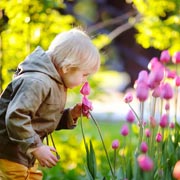 Children and families can take part at home as well as in participating schools, childcare settings, community groups, ‘outdoorsy’ retail outlets and even some National Trust properties.
Children and families can take part at home as well as in participating schools, childcare settings, community groups, ‘outdoorsy’ retail outlets and even some National Trust properties.
Commercial participant examples include places like formal gardens and garden centres. Such venues may lay on things like seed giveaways, bee hunts, bug hunts, garden treasure hunts, nature trails, recycled garden installations and lots of other activities to inspire gardening in children. They may include gardening-inspired activities like leaf printing, rock painting, plant colouring sheets, flower drawing competitions, vegetable planting classes, sunflower seed planting, and many more. Children will have lots to choose from, making for some seriously fun and inspiring trips during the week. Check out related activities in your local area in the run-up to the start of the event.
At home, there are a myriad of ways to take part in the event. Suggestions include:
 Sowing Wildflower Seeds
Sowing Wildflower Seeds
Sowing wildflower seeds can be super-easy for even the youngest children and, in fact, you can read our detailed children’s guide to growing wildflowers here. What’s more, pollinators like bees and butterflies will love the resulting flowers!
Growing Herbs
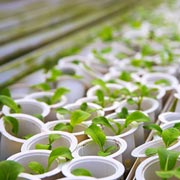 Herbs and some vegetables can be grown from seeds, cultivated, and harvested from simple flowerpots or yoghurt pots. They can also be ‘re-grown’ through various devious means that will fascinate children including under-fives. We wrote a whole post about that too, so take a look — it’s quite ingenious, is incredibly educational, and results in free food! What’s more, it can be done indoors. Learn more about how children can grow food at home, for free, here.
Herbs and some vegetables can be grown from seeds, cultivated, and harvested from simple flowerpots or yoghurt pots. They can also be ‘re-grown’ through various devious means that will fascinate children including under-fives. We wrote a whole post about that too, so take a look — it’s quite ingenious, is incredibly educational, and results in free food! What’s more, it can be done indoors. Learn more about how children can grow food at home, for free, here.
Grow Some ‘Egg Heads’ with Cress Seeds
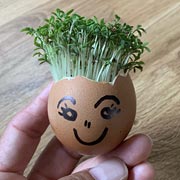 Another ‘indoor gardening’ activity is growing these comical ‘egg heads’. Grown simply from cress seeds, they can be grown in egg shells as shown, or another alternative would be yoghurt pots. When the cress is ready to be harvested and used in salads or as a garnish, the little characters can have a haircut! Here’s our guide that explains what to do.
Another ‘indoor gardening’ activity is growing these comical ‘egg heads’. Grown simply from cress seeds, they can be grown in egg shells as shown, or another alternative would be yoghurt pots. When the cress is ready to be harvested and used in salads or as a garnish, the little characters can have a haircut! Here’s our guide that explains what to do.
Bee-Friendly Gardening
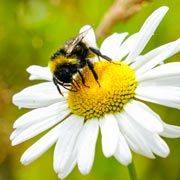 Another activity that children can get involved in for National Children’s Gardening Week is to create bee-friendly gardens. Our recent post about World Bee Day explains how to make a bee oasis (from where bees and pollinators can get a refreshing drink) and a bee-friendly garden. Check out those and some other bee-friendly activities here.
Another activity that children can get involved in for National Children’s Gardening Week is to create bee-friendly gardens. Our recent post about World Bee Day explains how to make a bee oasis (from where bees and pollinators can get a refreshing drink) and a bee-friendly garden. Check out those and some other bee-friendly activities here.
Make Free Compost
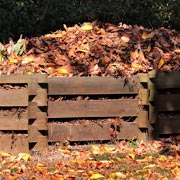 Plants love compost and so do minibeasts. So, another wonderful activity for children in National Children’s Gardening Week is to make homemade compost. Our dedicated guide to composting for kids explains everything children need to do for this hugely worthwhile, ecologically sound, and educational activity.
Plants love compost and so do minibeasts. So, another wonderful activity for children in National Children’s Gardening Week is to make homemade compost. Our dedicated guide to composting for kids explains everything children need to do for this hugely worthwhile, ecologically sound, and educational activity.
Flower Pressing
 Once the flowers are blooming outside, children can experiment with pressing flowers. Pressed flowers are a wonderful way for children to save flowers semi-permanently as keepsakes or to use as part of an art activity.
Once the flowers are blooming outside, children can experiment with pressing flowers. Pressed flowers are a wonderful way for children to save flowers semi-permanently as keepsakes or to use as part of an art activity.
TIP: highly-coloured flowers work best and smaller ones are also likely to flatten more easily and dry more quickly.
Once picked, flowers can be placed, ideally so they don’t overlap, between absorbent paper like newsprint, blotting paper, or tissue paper. Place this between the pages of a thick book or sketch pad that has an extra weight on top. Leave somewhere dry for a couple of weeks or so and they will flatten and dry, ready for use as a bookmark or as part of a creative art piece.
Make a Magical Fairy Garden
 The youngest children will love this activity! Children will need some scavenged moss, pebbles, sticks, seashells and perhaps small pieces of driftwood from a beach. Children can then use these to transform the soil in a large pot or on top of a log into a whimsical and magical-looking fairy garden. Children can let their imaginations run riot and create things like a fairy house made of sticks and driftwood, fairy lawns made of moss, and garden paths made with pebbles that form stepping stones. They could even include a fairy pond made with a small mirror, tin foil that covers the discarded lid of a jar, or real water in a mini flowerpot drip tray. Such fairy gardens can look truly magical!
The youngest children will love this activity! Children will need some scavenged moss, pebbles, sticks, seashells and perhaps small pieces of driftwood from a beach. Children can then use these to transform the soil in a large pot or on top of a log into a whimsical and magical-looking fairy garden. Children can let their imaginations run riot and create things like a fairy house made of sticks and driftwood, fairy lawns made of moss, and garden paths made with pebbles that form stepping stones. They could even include a fairy pond made with a small mirror, tin foil that covers the discarded lid of a jar, or real water in a mini flowerpot drip tray. Such fairy gardens can look truly magical!
The Activity Ideas are Endless!
We’ve highlighted just a handful of activity ideas that will fascinate, enthral and educate children this National Children’s Gardening Week. However, we’ve only scratched the surface and many more activities are possible with a bit of imagination. To give you some more ideas, check out these gardening-related activities for children and some eco-friendly gardening activities for kids here. Whatever activity they take part in, we wish every child a very enjoyable, fulfilling, and educational gardening week!
Little Cedars Day Nursery
the Natural Childcare Choice for Streatham Families

 Families can rest assured that children at Little Cedars Nursery in Streatham get ample opportunities to be around nature. The setting has outdoor areas where children can grow plants, flowers, fruit and vegetables. Doing so is something that they love and learn so much from. It teaches them new skills, hones motor skills, helps them develop a sense of responsibility and empathy, and teaches them about the world they live in. It’s just one small part of the comprehensive early years education they receive at Little Cedars Nursery. Here, we do everything we can to help them become the best versions of themselves. We give them the very best start in life, enabling them to be ready to thrive from the moment they leave us to begin school. If you’re interested in your child joining Little Cedars, please choose a contact option below to get started.
Families can rest assured that children at Little Cedars Nursery in Streatham get ample opportunities to be around nature. The setting has outdoor areas where children can grow plants, flowers, fruit and vegetables. Doing so is something that they love and learn so much from. It teaches them new skills, hones motor skills, helps them develop a sense of responsibility and empathy, and teaches them about the world they live in. It’s just one small part of the comprehensive early years education they receive at Little Cedars Nursery. Here, we do everything we can to help them become the best versions of themselves. We give them the very best start in life, enabling them to be ready to thrive from the moment they leave us to begin school. If you’re interested in your child joining Little Cedars, please choose a contact option below to get started.
Get started on your child’s nursery application today, arrange a guided tour, or ask a question:
Little Cedars Nursery is a ‘Good Provider’ and supports childcare funding for eligible children and babies from just 9 months of age. The nursery is in Streatham close to Tooting Common, Tooting, Furzedown, Balham, Norbury and Colliers Wood.
For the sake of their safety and well-being, young children should be supervised, and activities should be overseen by an adult whenever appropriate, especially outdoors.

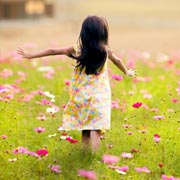 Sowing Wildflower Seeds
Sowing Wildflower Seeds
 Getting outdoors is the best way to see wildlife, especially if your family lives near a park or the countryside. Rambles, picnics, and simple walks are all obvious options and, of course, wildlife sanctuaries are a good choice if you have one nearby. That said, while such outdoor options are amongst the best ways for children to connect with nature, sometimes they’re simply not possible. However, when that’s the case, there are plenty of other possibilities including bringing the wonders of wildlife into your nursery, home, or garden. Here are some engaging, age-appropriate activities that will allow children to take part in World Wildlife Day whatever their circumstances:
Getting outdoors is the best way to see wildlife, especially if your family lives near a park or the countryside. Rambles, picnics, and simple walks are all obvious options and, of course, wildlife sanctuaries are a good choice if you have one nearby. That said, while such outdoor options are amongst the best ways for children to connect with nature, sometimes they’re simply not possible. However, when that’s the case, there are plenty of other possibilities including bringing the wonders of wildlife into your nursery, home, or garden. Here are some engaging, age-appropriate activities that will allow children to take part in World Wildlife Day whatever their circumstances: Most children naturally take to drawing, so encouraging them to draw wild animals, plants and birds will be a popular suggestion, especially around the time of World Wildlife Day. For example, they could try drawing British mammals like rabbits and squirrels, jungle animals like elephants and tigers, or sea creatures like dolphins and whales. To make it easier, perhaps give them some visual reference to inspire them. They could choose from a variety of media, be it pencils, crayons, paints, or collages — or something entirely different. Playdough or salt dough models are also an option. Children naturally love to create and, once complete, perhaps display their pieces to encourage future progress.
Most children naturally take to drawing, so encouraging them to draw wild animals, plants and birds will be a popular suggestion, especially around the time of World Wildlife Day. For example, they could try drawing British mammals like rabbits and squirrels, jungle animals like elephants and tigers, or sea creatures like dolphins and whales. To make it easier, perhaps give them some visual reference to inspire them. They could choose from a variety of media, be it pencils, crayons, paints, or collages — or something entirely different. Playdough or salt dough models are also an option. Children naturally love to create and, once complete, perhaps display their pieces to encourage future progress. Reading books about wildlife will introduce children to new animals and habitats. Great options for younger under-fives include ‘Dear Zoo’ by Rod Campbell and ‘Brown Bear, Brown Bear, What Do You See?’ by Bill Martin Jr. (author) and Eric Carle (illustrator). Also, of course, children and families have the option to tell each other made-up stories. They’re a great way to encourage creative thinking and can be approached in a number of different ways. For example, a parent could tell a story first to give the child an idea of
Reading books about wildlife will introduce children to new animals and habitats. Great options for younger under-fives include ‘Dear Zoo’ by Rod Campbell and ‘Brown Bear, Brown Bear, What Do You See?’ by Bill Martin Jr. (author) and Eric Carle (illustrator). Also, of course, children and families have the option to tell each other made-up stories. They’re a great way to encourage creative thinking and can be approached in a number of different ways. For example, a parent could tell a story first to give the child an idea of  Try making some simple bird feeders with your children. There are lots of easy ways to make them as outlined in our dedicated guide,
Try making some simple bird feeders with your children. There are lots of easy ways to make them as outlined in our dedicated guide,  Create a simple scavenger hunt using pictures, words, or our free nature hunt sheets to encourage children to find different natural objects like leaves, feathers, and pine cones. This activity builds children’s observation skills, gives them deep insights into nature, and instils in them a better appreciation for the environment. Currently, free reference sheets are available for
Create a simple scavenger hunt using pictures, words, or our free nature hunt sheets to encourage children to find different natural objects like leaves, feathers, and pine cones. This activity builds children’s observation skills, gives them deep insights into nature, and instils in them a better appreciation for the environment. Currently, free reference sheets are available for 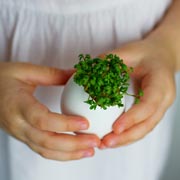 Engage children with easy science experiments, like
Engage children with easy science experiments, like 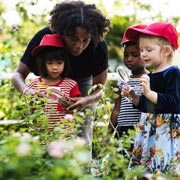 Spending time in nature or learning about wildlife isn’t just fun—it has incredible benefits for early childhood development. To harness such benefits, families can incorporate nature-based learning into children’s routines in a variety of ways. Examples include organising outdoor exploration sessions, setting up small wildlife observation areas, and using nature-themed storytelling to engage the young learners. Connecting children with nature:
Spending time in nature or learning about wildlife isn’t just fun—it has incredible benefits for early childhood development. To harness such benefits, families can incorporate nature-based learning into children’s routines in a variety of ways. Examples include organising outdoor exploration sessions, setting up small wildlife observation areas, and using nature-themed storytelling to engage the young learners. Connecting children with nature: Incorporating wildlife into children’s activities doesn’t have to be limited to one day. Encouraging youngsters to notice the birds in the garden, look for insects on nature walks, or watch the changing seasons can gift them a lifelong love of nature. Parents and families can make wildlife observation a regular habit, perhaps by keeping a simple nature sketchbook where children can draw or glue in pictures of what they see, or by creating a wildlife corner at home with books, nature finds, and small child-safe plants. Even setting up a bird-watching station near a window can turn everyday moments into exciting learning opportunities. By celebrating World Wildlife Day, we can inspire the next generation of nature lovers—one little explorer at a time!
Incorporating wildlife into children’s activities doesn’t have to be limited to one day. Encouraging youngsters to notice the birds in the garden, look for insects on nature walks, or watch the changing seasons can gift them a lifelong love of nature. Parents and families can make wildlife observation a regular habit, perhaps by keeping a simple nature sketchbook where children can draw or glue in pictures of what they see, or by creating a wildlife corner at home with books, nature finds, and small child-safe plants. Even setting up a bird-watching station near a window can turn everyday moments into exciting learning opportunities. By celebrating World Wildlife Day, we can inspire the next generation of nature lovers—one little explorer at a time!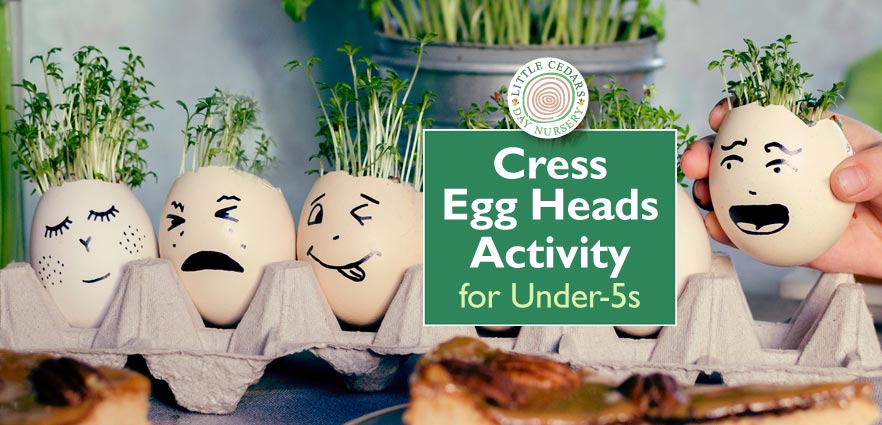
 A nature-based, food-related activity that young children can enjoy indoors at any time of the year is cress growing. Today we outline how it can be made even more fun and creative for kids by growing the cress as little ‘egg heads’. These come complete with comical faces and amusing hairstyles made of green cress shoots! Children will absolutely love it when they end up with little egg faces with spouting hairstyles that each have real character. And, they’ll even be able to eat the results!
A nature-based, food-related activity that young children can enjoy indoors at any time of the year is cress growing. Today we outline how it can be made even more fun and creative for kids by growing the cress as little ‘egg heads’. These come complete with comical faces and amusing hairstyles made of green cress shoots! Children will absolutely love it when they end up with little egg faces with spouting hairstyles that each have real character. And, they’ll even be able to eat the results! Cress is Easy to Grow, & Tasty!
Cress is Easy to Grow, & Tasty!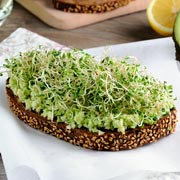 Growing Cress for Small Kids and Big Kids
Growing Cress for Small Kids and Big Kids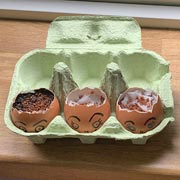 Next, find a vessel to prop the egg shells up in. This could simply be an egg cup or even an egg carton, like that shown in the photo. Then, decide what to fill the empty egg shells with. Children can choose either damp kitchen roll or damp compost/soil to grow the cress seeds on. Carefully fill the empty egg shells almost to the top with the chosen filler. (We tried both and each grew well. Interestingly, the cress seeds grown on kitchen roll tissue paper grew a little faster and therefore taller than those grown on compost. They therefore looked a bit more ‘wild’ — it was quite a surprise and had an amusing impact on the egg-people’s hairstyles).
Next, find a vessel to prop the egg shells up in. This could simply be an egg cup or even an egg carton, like that shown in the photo. Then, decide what to fill the empty egg shells with. Children can choose either damp kitchen roll or damp compost/soil to grow the cress seeds on. Carefully fill the empty egg shells almost to the top with the chosen filler. (We tried both and each grew well. Interestingly, the cress seeds grown on kitchen roll tissue paper grew a little faster and therefore taller than those grown on compost. They therefore looked a bit more ‘wild’ — it was quite a surprise and had an amusing impact on the egg-people’s hairstyles).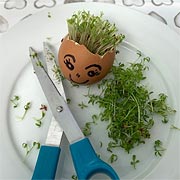 Within a week or so, the little egg heads should begin to sprout green ‘hair’ shoots!
Within a week or so, the little egg heads should begin to sprout green ‘hair’ shoots!